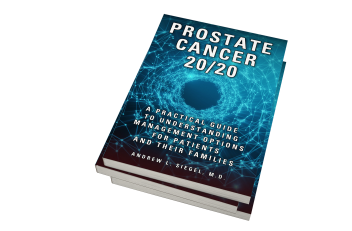Andrew Siegel MD 9/28/2019 Prostate Cancer Awareness Month

Thank you Marijana1 at Pixabay for image above
Last week’s entry covered androgen deprivation therapy (ADT), a means of managing prostate cancer by lowering serum testosterone to castrate levels, thus depriving prostate cancer cells of the male hormone testosterone. Today’s entry covers anti-androgens, which do not decrease testosterone production, but block the body’s ability to use testosterone, thus “starving” prostate cancer cells from being stimulated by testosterone. Their premise for being used is that even with ADT (LHRH analogs, LHRH antagonists or surgical removal of the testes), small amounts of testosterone made by the adrenal glands can result in prostate cancer growth.
Anti-androgen treatment may be combined with LHRH analogs, antagonists or surgical castration as first-line hormone therapy. This is called “combined androgen blockade” and functions to block adrenal as well as testicular testosterone. There is still some debate as to whether combined androgen blockade is more effective than using LHRH analogs, LHRH antagonists or surgical castration alone.
First generation anti-androgens include bicalutamide (Casodex), flutamide (Eulexin), and nilutamide (Nilandron). Ketoconazole (Nizoral), although primarily used to treat fungal infections, can also be used as second-line hormonal therapy to treat advanced prostate cancer, although concerns about side effects encouraged the development of newer-generation anti-androgens, including enzalutamide (Xtandi), abirataron (Zytiga), apalutamide (Erleada), and darolutamide (Nubeqa). Side effects of anti-androgens in patients already treated with LHRH agonists, LHRH antagonists or surgical castration are usually not serious. Diarrhea is the major side effect, although seizures, nausea, liver problems, and fatigue can also occur. Anti-androgens are commonly added to LHRH analogs, LHRH antagonists or surgical castration when the latter are no longer working effectively, as reflected by a rise in PSA.
A Few Words on CRPC (Castrate Resistant Prostate Cancer)
In 2019, approximately 75,000 men in the USA will be diagnosed with castration-resistant prostate cancer (CRPC), a condition in which the PSA continues to rise despite achieving castrate levels of testosterone on androgen deprivation therapy. 40% of these patients have prostate cancer that has not spread to other parts of the body (non-metastatic CRPC). Patients at this stage of prostate cancer typically do not have symptoms of the disease and the goal of treatment in this setting is to delay the spread of prostate cancer since one-third of men with non-metastatic CRPC will progress and develop metastases within two years (metastatic CRPC).
Newer generation anti-androgens

Most of the brand names of these new meds have 5-7 letters, 3 syllables, begin with rare consonants and end in a vowel. If they could be used in a game of Scrabble, they would be of great value!
Abiraterone (Zytiga), approved by the FDA in 2011, works by inhibiting an enzyme in the adrenal steroid biosynthesis pathway, which blocks the production of testosterone and other testosterone-like hormones. Recall that one of the mechanisms of resistance to ADT is the ability of the prostate cancer cells to produce their own testosterone; Zytiga can prevent this from occurring. It must be used in conjunction with steroids to counteract side effects including high blood pressure, electrolyte abnormalities and fatigue.
A clinical trial published in 2018 demonstrated that the addition of Zytiga and prednisone to ADT significantly increased overall survival and decreased the risk of prostate cancer progression in men with newly diagnosed metastatic castrate-sensitive prostate cancer, leading to a new FDA approval in 2018.
Enzalutamide (Xtandi), FDA approved in 2012, is a second-generation anti-androgen that works by blocking the activation of the androgen receptor by testosterone. In order for testosterone to function, it must first bind to the androgen receptor to activate it, after which it gets transported into the nucleus of the cell. Xtandi offers an advantage over the first-generation anti-androgens in that it binds with a stronger affinity to the androgen receptor. It was originally approved only for metastatic CRPC, but because studies showed that it delayed metastases and offered a survival benefit to men with non-metastatic CRPC, it was FDA approved in July 2018 for use in men with non-metastatic CRPC. Potential side effects include fatigue, back pain, diarrhea, constipation, joint aches, cardiac adverse effects, high blood pressure, increased liver enzymes and, rarely, seizures.
Apalutamide (Erleada) in 2018 became the first FDA approved treatment for non-metastatic CRPC. Erleada works by blocking the activation of the androgen receptor by testosterone, with similar properties to enzalutamide, bicalutamide, and nilutamide. Clinical studies have demonstrated its ability to significantly delay the time to symptomatic progression, metastasis and death. Side effects include rash, hypothyroidism, fractures, and rare seizures.
The latest addition to the group….On July 30 the FDA approved darolutamide (Nubeqa)– an androgen receptor inhibitor– for the treatment of patients with non-metastatic castration-resistant prostate cancer (CRPC). In clinical trials, patients on Nubeqa plus ADT demonstrated a median survival of 40.4 months versus 18.4 months for placebo plus ADT.
Wishing you the best of health,
![]()
A new blog is posted weekly. To receive a free subscription with delivery to your email inbox visit the following link and click on “email subscription”: www.HealthDoc13.WordPress.com
Dr. Andrew Siegel is a physician and urological surgeon who is board-certified in urology as well as in female pelvic medicine and reconstructive surgery. He is an Assistant Clinical Professor of Surgery at the Rutgers-New Jersey Medical School and is a Castle Connolly Top Doctor New York Metro Area, Inside Jersey Top Doctor and Inside Jersey Top Doctor for Women’s Health. His mission is to “bridge the gap” between the public and the medical community. He is a urologist at New Jersey Urology, the largest urology practice in the United States.
The content of this entry is excerpted from his new book, PROSTATE CANCER 20/20: A Practical Guide to Understanding Management Options for Patients and Their Families

Video trailer for Prostate Cancer 20/20
Preview of Prostate Cancer 20/20
Andrew Siegel MD Amazon author page
Prostate Cancer 20/20 on Apple iBooks
PROSTATE CANCER 20/20: A Practical Guide to Understanding Management Options for Patients and Their Families is now on sale at Audible, iTunes and Amazon as an audiobook read by the author (just over 6 hours).
Dr. Siegel’s other books:
PROMISCUOUS EATING— Understanding and Ending Our Self-Destructive Relationship with Food
MALE PELVIC FITNESS: Optimizing Sexual and Urinary Health
THE KEGEL FIX: Recharging Female Pelvic, Sexual, and Urinary Health